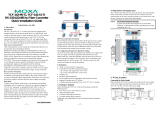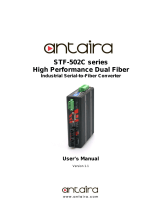Moxa ICF-1150-M-SC Installation guide
- Type
- Installation guide

ICF-1150 Series
Quick Installation Guide
First Edition, November 2008
© 2008 Moxa Inc. All rights reserved.
Reproduction without permission is prohibited.
Fl.4, No.135, Lane 235, Pao-Chiao Rd. Shing Tien City, Taipei, Taiwan,
R.O.C.
TEL: +886-2-8919-1230
P/N: 1802011500010

- 2 -
Overview
Introduction
The ICF-1150 series fiber converters are equipped with a multiple interface
circuit that can handle RS-232 and RS-422/485 serial interfaces, as well as
multi-mode or single-mode fiber. The ICF-1150 series converters are used to
extend serial transmission distance up to 5 km (ICF-1150-M, with multi-mode
fiber) or up to 40 km (ICF-1150-S, with single-mode fiber).
Why Convert Serial to Fiber?
Fiber communication not only extends the communication distance, but also
provides many advantageous features. IMMUNITY FROM ELECTRICAL
INTERFERENCE: Fiber is not affected by electromagnetic interference or
radio frequency interference. It provides a clean communication path and is
immune to cross-talk. INSULATION: Optical fiber is an insulator; the glass
fiber eliminates the need for using electric currents as the communication
medium. SECURITY: Fiber cannot be tapped by conventional electric means
and is very difficult to tap into optically. Furthermore, radio and satellite
communication signals can be captured easily for decoding. RELIABILITY &
MAINTENANCE: Fiber is immune to adverse temperature and moisture
conditions, does not corrode or lose its signal, and is not affected by short
circuits, power surges, or static electricity.
Reverse Power Protection
The Reverse Power Protection feature provides extra protection against
accidentally connecting the power cables to the wrong terminal. The converter
is designed to detect automatically which power wire is positive and which is
negative, and then adjust the power supply accordingly.
3-Way Communication
The ICF-1150 series supports 2 serial ports. The D-sub connector is for RS-232
communication and the removable terminal block is for RS-422 or RS-485
communication. The 3 ports (2 serial ports and one fiber port) are completely
independent. When the ICF-1150 series converters receive data from any port,
it will send data out through the other 2 ports. For example, when the ICF-1150
series converters receive a command from the remote Master via the fiber port,
it will convert the command and transmit it via the RS-232 port and
RS-422/485 port at the same time. So if the user is trying to monitor a system
running on the RS-485 network, there is no need to use an additional RS-232 to
RS-485 converter to connect the laptop computer’s serial port to the RS-485
bus.
ATTENTION
ICF-1150 is designed to receive data from one port and send
data to the other ports.
If ICF-1150 receive data from 2 ports at the same time, that
may cause the data error on all the RX ports.

- 3 -
Rotary Switch for Pull High/Low Resistor Setting
Since the RS-485 port can support multi-drop connection or daisy-chain
connection, system engineers can connect meters, RTUs, readers, or many
other devices together on the same bus. The impedance of the data line will rise
according to the number of serial devices on the same bus. To get the system
working, the ICF-1150 has a setting for tuning the pull high/low resistor. Just
turn the dial to find the best resistor value for the system without removing the
ICF-1150 from the DIN-rail. (The default settings are 1K for both switches.)
Pull High/Low Resistor
Position 0 1 2 3 4 5 6 7 8 9
Ohm 150K 10K 4.7K 3.3K 1K 909 822 770 500 485
DIP Switch for Selectable Terminator
The termination resistor for many products of this type is set by a jumper
located inside the product’s casing. To disable or change the resistor’s strength,
the user must open the casing to reset the jumper. Moxa offers a more
user-friendly solution that allows users to set the termination resistor with a
DIP switch located outside the ICF-1150 converter’s casing.
No Configuration Required for Baudrate Settings
The ICF-1150 works under any baudrate from 50 bps to 921.6 Kbps. The
ICF-1150 simply converts the signal back and forth between serial (RS-232,
RS-422, or RS-485) and fiber. Since the ICF-1150 does not need to interpret
the signal, it does not need to know the baudrate of the transmitting device. For
this reason, the ICF-1150 does not have any DIP switches or jumpers for
setting the baudrate.
Ring Mode
To allow one half-duplex serial device to communicate with multiple
half-duplex devices connected to a fiber ring, you should configure the
ICF-1150 for “ring mode” by setting DIP switch “SW3” to the “On” position.
The Tx port of a particular ICF-1150 unit connects to the neighboring
converter’s Rx port to form the ring. Note that when one node transmits a
signal, the signal travels around the ring until it returns back to the transmitting
unit, which then blocks the signal. Users should ensure that the total fiber ring
length is less than 100 km when using either single-mode models or
multi-mode models.

- 4 -
Features
y “Ring” or “Point to Point” transmission
y Extend RS-232/422/485 transmission distance:
¾ up to 40 km with single-mode—ICF-1150-S series
¾ up to 5 km with multi-mode—ICF-1150-M series
y Support baudrate up to 921.6 Kbps
y Provide 3-way galvanic isolation (for –I models)
y Wide operating temperature from -40 to 85°C (for “T” models)
Package Checklist
Before installing the ICF-1150, verify that the package contains the following
items:
y ICF-1150 Fiber Converter
y Quick Installation Guide
y Warranty Card
NOTE: Please notify your sales representative if any of the above items are
missing or damaged.
Mounting Dimensions (Unit : mm)
ICF-1150-SC
23.8
70 8.8
8.8
48.39
33.41
115
30.3

- 5 -
ICF-1150-ST
13.66
70
8.8
8.8
48.39
33.41
115
30.3
Top View
Front View
LED
Fiber Port
OP Mode Switch
Rotary Switch for Pull High/Low Resistor
RS-422/485
ATTENTION
Electrostatic Discharge Warning!
To protect the product from damage due to electrostatic
discharge, we recommend wearing a grounding device when
handling your ICF-1150 series.

- 6 -
Mounting
The aluminum DIN-Rail attachment plate should be fixed to the back panel of
the ICF-1150 when you take it out of the box. If you need to reattach the
DIN-Rail attachment plate to the ICF-1150, make sure the stiff metal spring is
situated towards the top, as shown in the figures below.
STEP 1:
Insert the top of the DIN-Rail into the slot just below the stiff metal spring.
STEP 2:
The DIN-Rail attachment unit will snap into place as shown below.
metel spring
DIN-Rail
metel spring
DIN-Rail
To remove the ICF-1150 series from the DIN-Rail, simply reverse Steps 1 and
2 above.
Pin Assignment
15
69
Pin RS-232
1 Null
2 TxD
3 RxD
4 Null
5 GND
6 Null
7 Null
8 Null
9 ---
12345
RS-422 4-wire RS-485 2-wire RS-485
1 GND GND GND
2 Rx- Rx- Data -
3 Rx + Rx + Data +
4 Tx - Tx -
5 Tx + Tx +

- 7 -
Fiber Cable
SC-Port Pinouts SC-Port to SC-Port Cable Wiring
Tx
Rx
AA
BB
Cable Wiring
A A
B B
ST-Port Pinouts ST-Port to ST-Port Cable Wiring
Tx
Rx
AA
B
Cable Wiring
A A
B B
B
ATTENTION
This is a Class 1 laser/LED product. Do not stare into the
laser beam.
Switch Settings
There are 4-DIP switches on the front panel of the ICF-1150.
Setting Switch 1 Switch 2
RS-422 ON OFF
2-wire RS-485 OFF ON
4-wire RS-485 OFF (default) OFF (default)
Fiber Mode Switch 3
Ring Mode ON
Point to Point mode OFF (default)
120Ω Terminator Switch 4
Enable ON
Disable OFF (default)

- 8 -
ATTENTION
For Fiber Ring Users:
If the Rx LEDs of the converter glow continuously, remove
the fiber cable and connect again, then the system will not
have the same condition.
NOTE: “Ring Mode” can only be used for half-duplex
applications.
LED Indicators
There are 3 LEDs on the front panel of the ICF-1150.
LED Color Function
PWR Green Steady ON: Power is ON
Fiber Tx Green When sending serial data from the fiber port
Fiber Rx Yellow When receiving data from the fiber port
Specifications
Serial Communication
Signals for RS-232 TxD, RxD, SGND
Signals for RS-422 TxD+, TxD-, RxD+, RxD-, SGND
Signals for 4-wire RS-485 TxD+, TxD-, RxD+, RxD-, SGND
Signals for 2-wire RS-485 Data+, Data-, SGND
Baudrate 50 bps to 921.6 Kbps
ESD protection 15 KV ESD
Fiber Communication
Connector type ST or SC
Distance Single-mode fiber for 40 km
Multi-mode fiber for 5 km
Support Cable : 8.3/125, 8.7/125, 9/125 or 10/125 μm
(single mode)
50/125, 62.5/125, or 100/140 μm
(multimode)
Wavelength ICF-1150-S: 1310 nm
ICF-1150-M: 850 nm
TX Output ICF-1150-S: > -5 dBm
ICF-1150-M: > -5 dBm
RX Sensitivity ICF-1150-S: -25 dBm
ICF-1150-M: -20 dBm
Point-to-Point Transmission Half or Full duplex
Multi-drop Transmission Half duplex, fiber ring
Environmental
Operating Temperature
0 to 60°C (32 to 142°F), 5 to 95 % RH
-40 to 85°C (-40 to 167°F) for –T Model
Storage Temperature -40 to 85°C (-4 to 185°F), 5 to 95 % RH
Power
Input Power Voltage 12 to 48 VDC
Power Line Protection 4 KV Burst (EFT), EN61000-4-4
2 KV Surge, EN61000-4-5
Reverse Power Protection Protects against V+/V- reversal
Over Current Protection Protects against 2 signals shorted together:
1.1A
Power Consumption ICF-1150-S/M-SC/ST: 127 mA @ 12V

- 9 -
ICF-1150I- S/M-SC/ST: 163 mA @ 12V
Mechanical
Dimensions (W × D × H) 30.3 × 70 × 115 mm
Material Aluminum (1 mm)
Gross Weight 135g
Regulatory Approvals
CE Class B
FCC Part 15 sub Class B
TÜV EN 60950-1
EMI EN55022 1998, Class B
EMS EN61000-4-2 (ESD), Criteria B, Level 4
EN61000-4-3 (RS), Criteria A, Level 3
EN61000-4-4 (EFT), Criteria B, Level 4
EN61000-4-5 (Surge), Criteria A, Level 3
EN61000-4-6 (CS), Criteria A, Level 3
En61000-4-8 (PFMF), Criteria A, Level 5
Free fall IEC 60068-2-32
MTBF 792085 hrs
Technical Support Contact Information
www.moxa.com/support
Moxa Americas:
Toll-free: 1-888-669-2872
Tel: +1-714-528-6777
Fax: +1-714-528-6778
Moxa China (Shanghai office):
Toll-free: 800-820-5036
Tel: +86-21-5258-9955
Fax: +86-10-6872-3958
Moxa Europe:
Tel: +49-89-3 70 03 99-0
Fax: +49-89-3 70 03 99-99
Moxa Asia-Pacific:
Tel: +886-2-8919-1230
Fax: +886-2-8919-1231
-
 1
1
-
 2
2
-
 3
3
-
 4
4
-
 5
5
-
 6
6
-
 7
7
-
 8
8
-
 9
9
Moxa ICF-1150-M-SC Installation guide
- Type
- Installation guide
Ask a question and I''ll find the answer in the document
Finding information in a document is now easier with AI
Related papers
-
Moxa ICF-1170I Series Quick setup guide
-
Moxa ICF-1150 Series Quick setup guide
-
Moxa ICF-1150 Series Quick setup guide
-
Moxa Technologies TCF-142-RM Series Quick Install Guide
-
Moxa Technologies TCF-142-RM Series Quick Install Guide
-
Moxa TCF-142-S-SC-RM Installation guide
-
Moxa TCF-142 Series Quick setup guide
-
Moxa TCF-142 Series Quick setup guide
-
Moxa ICF-1170I Series Quick setup guide
-
Moxa ONCELL G2110-T User manual
Other documents
-
ICP DAS USA I-2541 User manual
-
 Moxa Technologies RS-232/422/485 to Fiber Converter User manual
Moxa Technologies RS-232/422/485 to Fiber Converter User manual
-
Black Box MED100A User manual
-
CTC Union IFC-Serial User manual
-
Westermo GDW-11 User guide
-
 ANTAIRA STF-502C series User manual
ANTAIRA STF-502C series User manual
-
GearMo RS-232 User guide
-
Korenix JetCon 2201-w Quick Installation Manual
-
Moxa Technologies 1100 User manual










